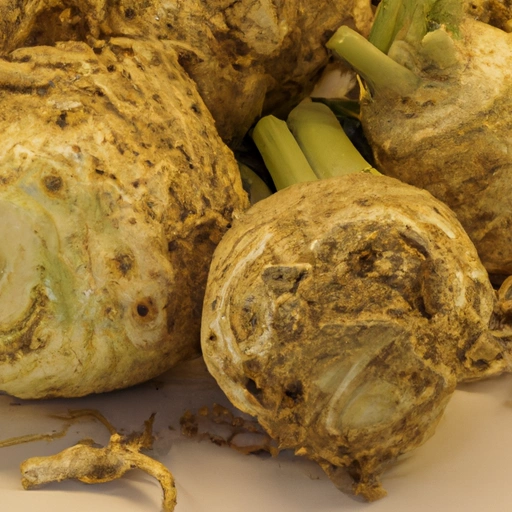Celery Root
Description

Celery root, also known as celeriac, is a type of root vegetable that is often overlooked in favor of its more popular relative, the celery stalk. Despite its rough, knobby exterior, celery root is a versatile ingredient known for its earthy flavor and nutrient-rich profile. In recipes, celery root is typically measured in cups or grams, with conversions available for American (cups, ounces) and European (grams, milliliters) units.
Common uses
Celery root is commonly used as a flavor enhancer in soups and stews, as well as a stand-alone side dish when roasted or mashed. It is also shredded raw into salads for a crisp, refreshing bite.
Nutritional value
Calories
A 100-gram serving of celery root contains approximately 42 calories (175 kJ).
Protein
Each 100 grams of celery root provides about 1.5 grams of protein.
Fat
Celery root is low in fat, with only 0.3 grams per 100 grams.
Carbohydrates
Celery root contains about 9.2 grams of carbohydrates per 100 grams, of which 1.8 grams are dietary fiber.
Vitamins
It is a good source of Vitamin K, providing 41% of the RDA per 100 grams, and contains moderate amounts of Vitamin C and some B vitamins.
Minerals
The root vegetable is rich in minerals such as phosphorus, potassium, and manganese.
Health benefits
Celery root is beneficial for digestive health due to its fiber content, can support bone health with its Vitamin K, and its variety of vitamins and minerals contribute to overall wellness and immune system support.
Potential risks
Those with a celery allergy should avoid celery root, and individuals with kidney issues should monitor potassium intake. Overconsumption can lead to gastrointestinal discomfort due to its fiber content.
Common recipes
Celery root is often used in the classic French dish 'celeriac remoulade,' as well as in soups like 'potage Crecy' and 'celery root bisque.' It can also be found in various European and American roasts and gratins.
Cooking methods
This vegetable can be roasted, boiled, mashed, pureed, or eaten raw. It adapts well to sous-vide cooking, steaming, and sautéing methods.
Pairing with other ingredients
Celeriac pairs well with apples, nuts, mustard, and robust meats like pork and duck. It complements creamy sauces and dressings with its subtle, nutty taste.
Summary
Celery root, or celeriac, is a nutritious and versatile root vegetable with a rich history and a variety of uses in the kitchen. From raw salads to hearty soups and purees, celery root offers a unique flavor and a plethora of health benefits. Whether measured in cups, ounces, or grams, it is a global ingredient that can be incorporated into recipes from all over the world, making it a valuable addition to any culinary repertoire.